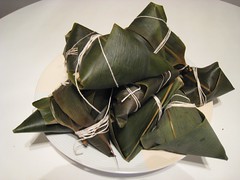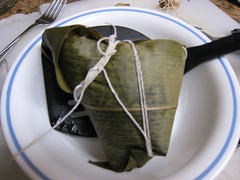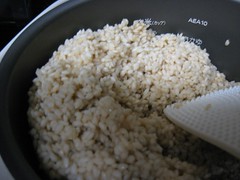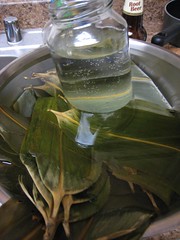Zhongzi is sweet rice with filling wrapped in a bamboo leaf, a sort of Chinese version of a tamale. The filling may include some or all of the following: pork, brine shrimp, Chinese sausage, egg , bamboo shoots, peanuts, chestnuts, mushrooms, and woodear.
Zhongzi are sometimes available as a part of restaurant's dimsum menu, but because the majority of their clientele is Chinese immigrants, the traditional recipe is used, which includes items in the filling that I dislike in my zhongzi.
Traditionally, this is the food that is eaten to celebrate the Dragon Boat Festival (which just happened to fall this past weekend). As the old story goes, during the Warring States period in China, a poet by the name of Qu Yuan who lived in the Kingdom of Chu tried to warn his countrymen and king about the advances being made by their Qin neighbors; when the Qin took the capital of Chu, he penned his final poem, and threw himself into the river; according to legend, the villagers threw packets of rice into the water to prevent the fish from eating the poet's body; in another version of the story, the packets of rice are thrown to appease a dragon who lived in the river.
I have many memories of eating these growing up, and I attempted for the first time to make my own. Because of the time involved in making these, one usually makes a large batch of zhongzi; after they are cooked, zhongzi can be frozen and kept for years -- the oldest zhongzi ever found is about 700 years old; mine won't last nearly that long (I suspect they'll be gone by the end of the week).
Instructions for preparing this dish are in the extended.
Soak Bamboo Leaves overnight in a large container of water. Bamboo leaves come in large bundles; depending on how you wrap them, you'll want 1 or 2 for each zhongzi. This recipe uses approximately 6 cups of rice to make 14 small zhongzi, so I would soak about 20 - 25 leaves. Because they take so long to soak, soak a few extra just in case. They need to be completely covered with water, and should turn darker as they absorb the water. The more flexible they are, the easier the wrapping of the zhongzi will be. I used a jar of water to weigh them down in the bowl, but anything can be used, so long as it keeps the leaves submerged.
How to Prepare the Zhongzi Filling
Depending on what you want in the zhongzi, this can be as easy as chopping up a few vegetables or as time consuming as braising meat.
Dried mushrooms and dried shrimp should be left in a pot of hot/warm water for hours to absorb the water and become soft.
After pan frying the meat in spices, soy sauce and rice wine, I stew the meat for an hour in the broth left by the soaking of the dried mushrooms.
How to Prepare the Sweet Rice.
Don't wash the sweet rice. Most of the nutrition on sweet rice is lost by washing the rice. Traditionally, this is where the rice is flavored with soy sauce; and where most Chinese people will tell you to pour and mix soy sauce until it looks brown enough; this is where I tell you to leave it alone (I don't like my rice too salty). You can mix in a little oil (1 - 2 tablespoons) so that the rice won't stick to the bamboo leaf so much.
Putting Zhongzi Together
I find it easier to keep the filling and the rice separate, but I know people who also mix the rice and the filling together. You'll want to prepare some cotton string for the next step; the bigger your zhongzi is, the more string you'll want; ideally, the string should about 3 to 5 feet long, enough to wrap around the middle of the zhongzi and keep it together. My mother makes pyramidal shaped Zhongzi using two pieces of bamboo leaf; I'll need to watch carefully next time to see how it's done; For me, I adopted a style similar to that of making a tamale, using just one bamboo leaf, and creating a cone for the rice and filling to be placed in. Then just tie the envelope together. Repeat until all the rice and filling is gone.
Cooking the Zhongzi
After all the packets are put together, it is time to cook the zhongzi; there are two ways of doing this: boiling and steaming; boiling is quicker, but also has the problem of having packets potentially explode in the pot. I also find that my wrapping is not good enough to prevent water from entering the zhongzi, which leads to sticky, but grainier rice; next time I'll try steaming, which hopefully will lead to clumpy rice. Boiling is about an hour, steaming is about 3 hours.
Storing Zhongzi
My mother always hung the zhongzi from the kitchen cabinets to dry after steaming; doing this allows them to harden a little and dries out the leaves; there's a lovely fragrance of wet bamboo in the kitchen for the next couple of days as we eat through the zhongzi. Alternatively, you can also toss them into the freezer, and a few minutes in the microwave ought to heat them back up.





mmm....
I moved in Melbourne, Australia a few years ago and settled here after uni. I grew up in Brunei by the way, where there is a sizable chinese population.
A few weeks ago, I found out that an Asian grocer nearby sold these (I call them zhongzhi as my family speaks mandarin. I think Ba Zhang is the hokkien name for them?) and I've been buying quite a few each week and eating them as snacks and bringing them to work as lunch. I think I'm actually missing home, the reason for which these zhongzhi taste especially good.
Very yummy. The one's I'm used to are called the 'nonya version' as the chinese who've settled in Southeast Asia over several generations, the females anyway are called nonya. In them are bits of pork, lots of pork fat (beauuuuutiful pork fat, makes the rice yummier after squishing it in), a piece of chestnut, a piece of mushroom, some seeds... I don't know what seeds, maybe lentil or barley, and a part of the egg yolk from a duck's egg, which I detest and would request they be made without if I had the guts. It also has some dried shrimp in it too.
Beautiful. Bring's back memories of home, when mom would buy a big bunch home. I don't remember how it was reheated though. I think she steamed them. Either way..... yummm..... I don't think we ever made them at home though, which is a pity.